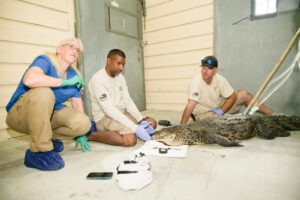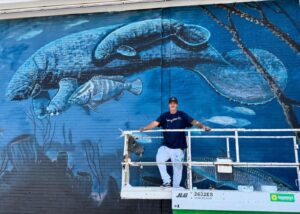
It is both an environmental and public relations disaster for Florida. Photos of dead fish and mammals, and videos of neon green algae mats are nothing short of alarming. It has the attention of national media outlets, as well as tourists who understand it’s unsafe to take a dip. Environmental agencies and state government are scrambling to address the problem. Here in the Keys, where many take the preservation of our natural resources so seriously, blue green algae is cause for alarm even though it isn’t in our “backyard,” the Florida Bay.
But it is closely related to local problems in Florida Bay — specifically the drought of 2015 that killed approximately 50,000 acres of sea grass. The algae to the north, and the high salinity conditions of Florida Bay, are both connected to the reconfiguration of the Everglades in the early 20th century to “drain the swamp.”
Following are some frequently asked questions about the situation.
Can the “blue green algae” bloom spread to the Keys?
The short answer is no.
“Once it’s exposed to saltwater, it dies. The idea that it would make it all the way down to the Keys is not plausible,” said Shannon Estenoz, a Key West native and chief operating officer for the Everglades Foundation.
The algae clogging the Caloosahatchee River to the west of Lake Okeechobee, and the St. Lucie River to the east, is a freshwater bacteria that is able to photosynthesize. The nutrients, or agricultural fertilizer, are literally the fuel of the crisis.
Have there been algae blooms in the Keys?
Yes, but not like that.
Algae blooms in the Keys are the result of “die-offs” or temperature spikes. When the water gets too salty, or too warm, seagrass dies. Its nutrients are then released into the water column, acting as a natural fertilizer for algae.
“That sets off a chain reaction,” said Tom Van Lent, vice president of science and education for the Everglades Foundation, and a 22-year resident of Key Largo. “Small algae clogs the pores of sponges which clean water, and when the sponges die, that blocks even more light and kills more seagrass.”
What’s the current state of Florida Bay?
It’s fragile.
“We’re still recovering from the drought of 2015,” said Van Lent, adding that it took 15 years to recover from the second-to-last event in Florida Bay. The drought caused fatal levels of salinity. “We need absolutely perfect conditions for a long time to get seagrass recruitment started again. Wet years help, but it’s going to take a long time.”
In Florida Bay, rainfall usually exceeds evaporation during summer months. But from January through May, it’s a “knife’s edge,” Van Lent said. Florida Bay isn’t receiving enough fresh water because of water management projects in the Everglades that divert water to the east and west, and impedes flow south.
What about the red tide?
It’s a naturally occurring algae bloom, first reported in the 16th Century by exploring Spaniards. It only occurs in saltwater and it originates offshore, so the connection to manmade pollution is unclear — however, it is certainly exacerbating the water conditions in areas already suffering from the blue green algae bloom.
Scientists monitor red tide (http://myfwc.com/research/redtide/statewide/) and there is no reported bloom in the Florida Keys currently. Scientists can forecast red tide movement using wind and water current data. In addition to killing fish, it can also affect the human respiratory system. Not to sound too technical here, but it feels “burny” — both in the lungs and in the eyes.
What’s being done?
It’s complicated.
The bad news is the terrible devastation caused by the green-blue algae bloom. The good news is the heightened awareness of the need for expedited Everglades restoration, or the reconfiguring of Lake Okeechobee’s watershed. Water that once moved north to south in the lake is now being diverted east and west.
What makes the situation worse, is the irrigation needs of the state’s agricultural industry. When it’s dry, the farms can draw water out of the lake — a legally permitted use of that water. But when it rains over the area — like it did in May raising the lake’s water table almost two feet in about two weeks — the farmers don’t need the extra water. The Army Corps of Engineers must divert the water east and west, as quickly as possible, to protect the infrastructure as well as local populations.
What’s the plan?
There has been a plan in place for 18 years to rectify this situation. It’s called the Central Everglades Planning Project — a group of water storage and conveyance projects south of Lake Okeechobee that will allow additional clean water to be directed south into the Everglades National Park and Florida Bay. There has been some movement recently:
• Possibly the most important is how White House Office of Management and Budget has approved the plans for the EAA Reservoir. It now must go before Congress for funding. The reservoir would be located just south of Lake Okeechobee and would function like a rain barrel. It would allow authorities to store and clean water rather than discharging polluted lake waters into the estuaries to the east and west.
The South Florida Water Management District has said the 10,100-acre reservoir and 6,500-acre manmade marsh would reduce discharges to both rivers by 63 percent and provide 120 billion gallons of clean water for the Everglades every year.
• The S-333 construction project recently received a $6 million investment and a schedule bump from Tallahassee. It borders highway 41, or the Tamiami Trail, and would result in twice as much water being able to flow south — 2,500 cubic feet per second. With more water moving south, there isn’t as much pressure to discharge east and west, and it helps the water-starved southern end of the state.
• The C-111 construction project, started in 2010, is pretty much complete. It pumps 290 million gallons of water daily to the eastern edge of the park. Now, there might be a tussle over how it’s operated — as a restoration project, or a flood plain protection project for population centers east of the park.
We have got to prioritize water quality — it is the foundation on which we build everything. We, as Floridians, do not get to reap the benefits of a thriving and robust economy, good jobs, good schools, safe drinking water if we don’t prioritize clean water. We have to do that at the polls in November. Clean water is all about politics. — Elizabeth Jolin, Florida Bay Forever
TIMELINE:
JUNE 20
Florida issues an emergency order urging the Army Corps of Engineers to redirect Lake Okeechobee water flow discharges to the Caloosahatchee and St. Lucie rivers.
JULY 9
Gov. Rick Scott declares a state of emergency over algae blooms.
JULY 10
White House Office of Management and Budget approves plans for the EAA Reservoir project. It is expected to cost $1.6 billion. It now awaits funding approval from Congress.
JULY 12
State orders Department of Economic Opportunity to conduct “emergency business damage assessment” surveys.
JULY 23
State authorizes $3 million in grants to help mediate damage and clean up of the algae bloom.
AUG. 7
State approves additional $400,000 in funding to Lee County (Fort Myers) to manage algae bloom.
AUG. 7
FWC waives rules related to dead fish clean ups, but orders populace not to touch rare fish or mammals.
AUG. 10
Gov. Rick Scott tours Stuart, Florida, by boat to see algae bloom effects.
AUG. 13
Scott declares state of emergency for Collier, Lee, Charlotte, Sarasota, Manatee, Hillsborough and Pinellas counties for red tide, for scientists, resources for cleanup, monitoring and marketing.
















